For several years after I first arrived in Taiwan, my exploration of Yangmingshan National Park (陽明山國家公園), Taipei’s gift to lovers of the outdoors, basically meant following wide, stone-slabbed trails to popular spots like Juansi Waterfall (絹絲瀑布), Cisingshan (七星山), and Lengshuikeng Hot Spring (冷水坑溫泉).
My options increased a bit after picking up a copy of the rather basic National Park-produced English-language map. Yet according to that, the only trails were those wide, stone-faced pedestrian highways, and the only natural attractions a couple of attractive but rather small waterfalls, a small lake and a handful of peaks.
However, there’s vastly more to the national park than the few well-known sights, and plenty of scope for the more ambitious, well prepared hiker to explore off the beaten track, especially in the remoter northern and eastern areas.
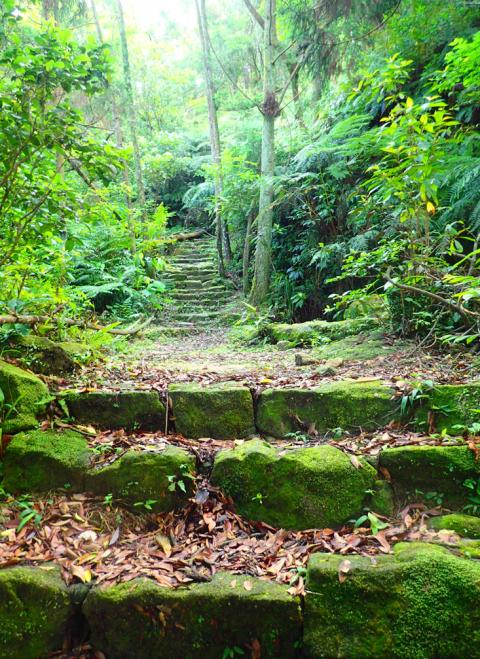
Photo: Richard Saunders
Despite its proximity to the big city, its accessibility by public transport and the popularity of the easier hikes with families, Yangmingshan National Park can get very rough and very wild surprisingly quickly once you leave the tourist trail.
Before entering its remoter regions (some of which require permits obtained in advance), be sure of your ability and gear, check the weather and carry a good map or GPS, as it’s notoriously easy to get lost in there.
One fascinating place that can be easily and safely explored by everyone (and in all weathers) is the curiously-named Pamir Park (帕米爾公園), which sits just inside the southeast corner of the national park, right on one of northern Taiwan’s premier cycling routes.
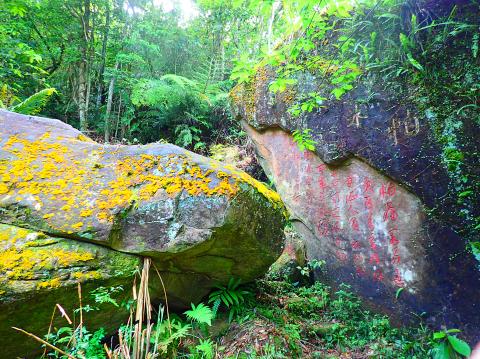
Photo: Richard Saunders
Few cyclists or motorists chugging uphill give a second thought to the few, rather decrepit features of the park that are visible from the road. In fact, it’s not a park at all, but a densely wooded, wild patch of natural hillside crossed by stone paths and steps and dotted with weathered statues of luminaries from the golden age of the Republic of China, with the odd rest shelter or shrine for good measure.
THE GREAT ESCAPE
It’s no accident that Pamir Park is named after the range of mountains that rise to over 7km in Tajikistan, Afghanistan and the northwestern corner of China.
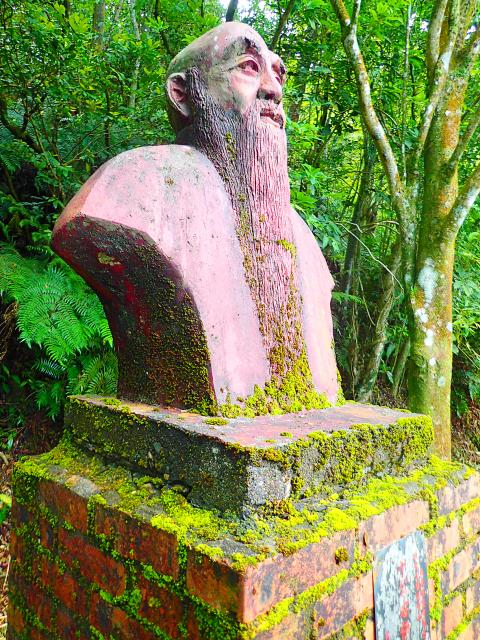
Photo: Richard Saunders
Following the defeat of the Chinese Nationalist Party (KMT) during the Chinese Civil War in 1949, a group of about 400 KMT soldiers in the far northwest province of Xinjiang fled the country, passing through Kashmir, what is today Pakistan and India and across Southeast Asia to Singapore, before finally arriving by boat in Taiwan. So difficult was the journey — especially the trip over the Pamir mountains — that there were many casualties, and only about 300 soldiers completed the journey.
A society was established in 1950 to commemorate their feat, with the splendid name of Pamir Snow Gnawing Association (帕米爾同志會). In 1961, the society created the Pamir Park and the Pamir Culture Center (in a now dilapidated building just below the park).
The main part of the park is above the road, past some huge moss-covered boulders that are inscribed with calligraphy by the famed calligrapher, scholar and politician, Yu You-jen (于右任), a major figure in the Tongmenghui (同盟會), a secret society dedicated to the overthrow of the Qing Dynasty in the years leading up to 1911. At the ripe old age of 71, Yu followed the KMT to Taiwan in 1949, and served in the new government, formed the following year. Yu was especially moved by that epic trip across the Pamir Mountains, and wrote in praise of the soldiers’ incredible effort. A bust of the great man, with a long, flowing beard, tops one of the big natural rock formations just inside the entrance to the park. Yu died in 1964, and is buried in an imposing and very elaborate tomb above route 101甲, also known as the Balaka Highway (巴拉卡公路), about a kilometer west of Datun Nature Park (大屯自然公園).
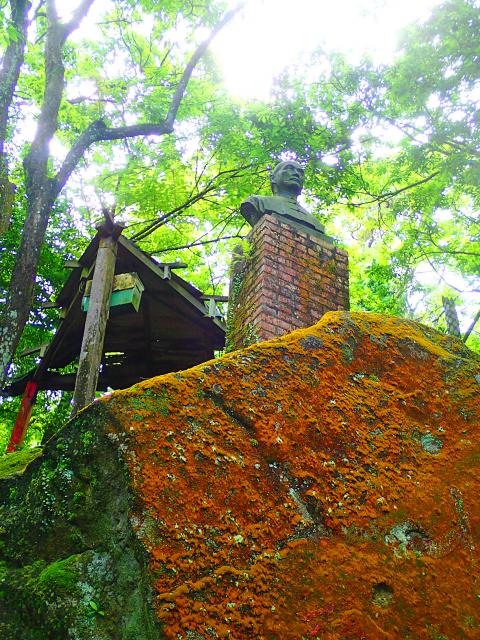
Photo: Richard Saunders
Continuing uphill, slippery moss-covered steps climb the wooded hillside, passing several discreetly landscaped features such as small pools, artificially diverted streams and cascades, all now half-covered by the encroaching undergrowth.
A couple more statues and busts stand in the middle of clearings. The one which to a Western visitor might look vaguely like a Chinese Alfred Hitchcock actually depicts the leader of the Pamir Snow Gnawing Association.
At the highest point of the park, at the back of a large open grassy area with a fine view over distant Taipei city, is a statue of Sun Yat-sen (孫中山). In front of it, a little lower down the hillside, is a tall obelisk with eight marble tablets, each carved with calligraphic characters originally executed by Yu.
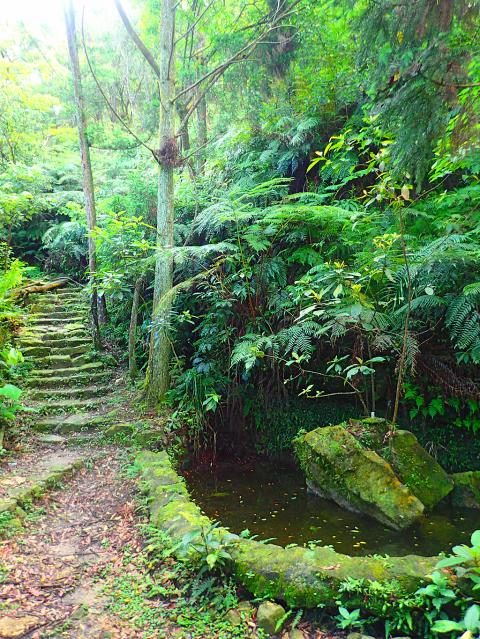
Photo: Richard Saunders
By the way, the famous bronze statue that once crowned the summit of Yushan (玉山) was a bust of Yu You-jen. It was pushed off the cliffs by vandals in 1996, but once occupied the spot where now stands the familiar chunk of rock carved with the characters for “Yushan Main Peak,” and its height above sea level.
Richard Saunders is a classical pianist and writer who has lived in Taiwan since 1993. He’s the founder of a local hiking group, Taipei Hikers, and is the author of six books about Taiwan, including Taiwan 101 and Taipei Escapes. Visit his Web site at www.taiwanoffthebeatentrack.com.

May 18 to May 24 Pastor Yang Hsu’s (楊煦) congregation was shocked upon seeing the land he chose to build his orphanage. It was surrounded by mountains on three sides, and the only way to access it was to cross a river by foot. The soil was poor due to runoff, and large rocks strewn across the plot prevented much from growing. In addition, there was no running water or electricity. But it was all Yang could afford. He and his Indigenous Atayal wife Lin Feng-ying (林鳳英) had already been caring for 24 orphans in their home, and they were in

On May 2, Chinese Nationalist Party (KMT) Chairman Eric Chu (朱立倫), at a meeting in support of Taipei city councilors at party headquarters, compared President William Lai (賴清德) to Hitler. Chu claimed that unlike any other democracy worldwide in history, no other leader was rooting out opposing parties like Lai and the Democratic Progressive Party (DPP). That his statements are wildly inaccurate was not the point. It was a rallying cry, not a history lesson. This was intentional to provoke the international diplomatic community into a response, which was promptly provided. Both the German and Israeli offices issued statements on Facebook

Even by the standards of Ukraine’s International Legion, which comprises volunteers from over 55 countries, Han has an unusual backstory. Born in Taichung, he grew up in Costa Rica — then one of Taiwan’s diplomatic allies — where a relative worked for the embassy. After attending an American international high school in San Jose, Costa Rica’s capital, Han — who prefers to use only his given name for OPSEC (operations security) reasons — moved to the US in his teens. He attended Penn State University before returning to Taiwan to work in the semiconductor industry in Kaohsiung, where he

President William Lai (賴清德) yesterday delivered an address marking the first anniversary of his presidency. In the speech, Lai affirmed Taiwan’s global role in technology, trade and security. He announced economic and national security initiatives, and emphasized democratic values and cross-party cooperation. The following is the full text of his speech: Yesterday, outside of Beida Elementary School in New Taipei City’s Sanxia District (三峽), there was a major traffic accident that, sadly, claimed several lives and resulted in multiple injuries. The Executive Yuan immediately formed a task force, and last night I personally visited the victims in hospital. Central government agencies and the